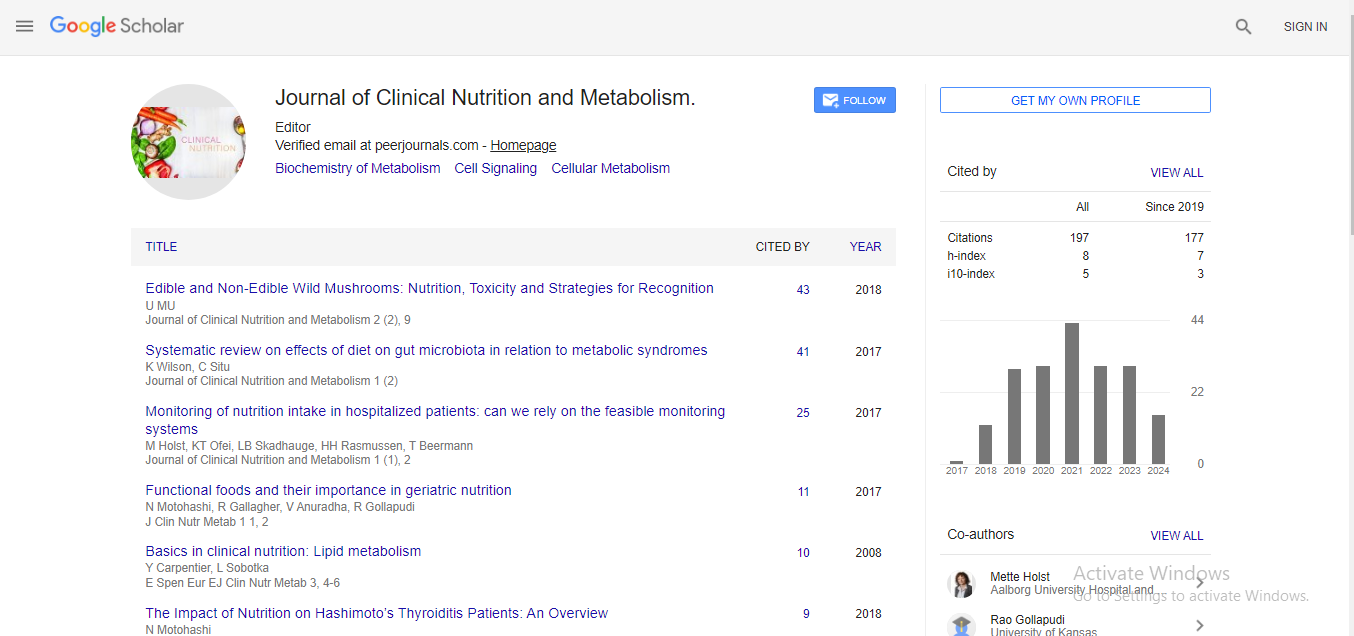Letter to Editor, J Clin Nutr Metab Vol: 5 Issue: 4
Metabolomic Studies in the Inherent Failure of Alkaptonuria Metabolism show Biological changes in Tyroleum Metabolism
Brendan P. Norman*
Department of Life Course and Medical Sciences, University of Liverpool, UK
*Corresponding Author:
Brendan P. Norman
Department of Life Course and Medical Sciences, University of Liverpool, UK
E-mail: bnorman@liv.ac.uk
Received Date: June 03, 2021; Accepted Date: July 14, 2021; Published Date: July 21, 2021
Citation: Norman BP (2021) Metabolomic Studies in the Inherent Failure of Alkaptonuria Metabolism show Biological changes in Tyroleum Metabolism. J Clin Nutr Metab 5:4. 124.
Copyright: © All articles published in Journal of Clinical Nutrition and Metabolism are the property of SciTechnol, and is protected by copyright laws. Copyright © 2021, SciTechnol, All Rights Reserved.
Abstract
Alkaptonuria (AKU) is an inherited disorder of tyrosine metabolism caused by lack of active enzyme homogentisate 1,2-dioxygenase (HGD). The primary consequence of HGD deficiency is increased circulating homogentisic acid (HGA), the main agent in the pathology of AKU disease. Here we report the first metabolomics analysis of AKU homozygous Hgd knock out (Hgd/) mice to model the wider metabolic effects of Hgd deletion and the implication for AKU in humans. Untargeted metabolic profiling was performed on urine from Hgd /AKU (nZ15) and Hgdþ/non-AKU control (nZ14) mice by liquid chromatography high-resolution time-of-flight mass spectrometry (Experiment 1). The metabolites showing alteration in Hgd/were further investigated in AKU mice (nZ18) and patients from the UK.
Keywords: Biotransformation, Metabolism, Metabolomics, Mice
Alkaptonuria (AKU) is an inherited disorder of tyrosine metabolism caused by lack of active enzyme homogentisate 1,2-dioxygenase (HGD). The primary consequence of HGD deficiency is increased circulating homogentisic acid (HGA), the main agent in the pathology of AKU disease. Here we report the first metabolomics analysis of AKU homozygous Hgd knock out (Hgd/) mice to model the wider metabolic effects of Hgd deletion and the implication for AKU in humans. Untargeted metabolic profiling was performed on urine from Hgd /AKU (nZ15) and Hgdþ/non-AKU control (nZ14) mice by liquid chromatography high-resolution time-of-flight mass spectrometry (Experiment 1). The metabolites showing alteration in Hgd/were further investigated in AKU mice (nZ18) and patients from the UK.
Alkaptonuria (AKU) is a rare disorder of tyrosine metabolis caused by congenital lack of activity of the enzyme homogentisate 1, 2-dioxygenase HGD .1Thebiochemical consequence of HGD deficiency is increase dhomogentisic acid (HGA) in the circulation, the pathogno-monic sign of the disease and central to its patho physiological features.2HGA has a high affinity for collagenous tissues, where its deposition produces striking pigmenta-tion, 3a process called ochronosis. Cartilage of load-bearing joints is particularly susceptible to ochronosis. Presence of HGA-derived pigment in these joints alters the physico-chemical properties of cartilage that support normal transmission of load and results in an inevitable and severe early-onset osteoarthropathy. Metabolomics has emerged as an invaluable approach for studying AKU. In our laboratory we have developed a targeted approach with specific mass spectrometric assays asan aid for diagnosis and monitoring of AKU.6, 7 these assays offer precise quantification of tyrosine pathway metabolites including HGA in serum and urine. More recently, astrategy has been developed for profiling and chemical identification of up to 619 related and more general me-tabolites by high-resolution accurate mass and retention time using liquid chromatography quadru pole time-of-flight mass spectrometry (LC-QTOF-MS).8Application of this technique to AKU serum9and urine8enabled the discovery of previously unknown metabolite and metabolic path way alterations following treatment with the HGA-lowering agent nitis in one. Metabolic profiling therefore has potential in AKU as both a phenol typing and biomarker discovery tool. However, to our knowledge, untreated AKU has not been compared with non-AKU at the metabolome level before.
The data reported form part of the first recorded metabolomewide comparison obtained from untreated AKU versus non-AKU animal models and shows, for the first time, that the overproduced HGA in AKU undergoes pre-dominantly phase II metabolic bio transformations. Phase Metabolism involves conjugation reactions to form sulfate, glucuronide, glutathione, mercapturic acid, amino acid, methyl and acetyl conjugates.The predominant sulfation and glucuronidation biotransformations observed for HGA are also essential aspects of metabolism of otherphenolic acids, bile acids, steroids and numerous otherendogenous biochemicals. The phase I metabolism reactions of hydroxylation, oxidation, reduction and hydrolysis were relatively minor. Further, our data indicate that the biochemical consequences of HGD deficiency extend beyond tyrosine metabolism.In conclusion; we have shown that targeted homozygous disruption to the Hgdgene induces previously unknown metabolite changes in a complex network of pathways associated with altered tyrosine metabolism. These changes include the biotransformation of HGA by mainly phase II metabolic processes and relatively little by phase I.This observation will encourage further as yet unexplored potential treatment targets for detoxification of HGA, the culprit molecule in AKU. The wider take-home message of this study is that inherited metabolic diseases, such as AKU, present unique windows into metabolism that can uncover associations between metabolic pathways in physiology and biochemistry more generally.
 Spanish
Spanish  Chinese
Chinese  Russian
Russian  German
German  French
French  Japanese
Japanese  Portuguese
Portuguese  Hindi
Hindi 